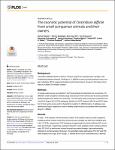The zoonotic potential of Clostridium difficile from small companion animals and their owners
Rabold, Denise
Espelage, Werner
Sin, Muna Abu
Eckmanns, Tim
Schneeberg, Alexander
Neubauer, Heinrich
Möbius, Nadine
Hille, Katja
Wieler, Lothar H.
Seyboldt, Christian
Lübke-Becker, Antina
Background: Clostridium difficile infections (CDI) in humans range from asymptomatic carriage to life-threatening intestinal disease. Findings on C. difficile in various animal species and an overlap in ribotypes (RTs) suggest potential zoonotic transmission. However, the impact of animals for human CDI remains unclear. Methods: In a large-scale survey we collected 1,447 fecal samples to determine the occurrence of C. difficile in small companion animals (dogs and cats) and their owners and to assess potential epidemiological links within the community. The Germany-wide survey was conducted from July 2012-August 2013. PCR ribotyping, Multilocus VNTR Analysis (MLVA) and PCR detection of toxin genes were used to characterize isolated C. difficile strains. A database was defined and logistic regression used to identify putative factors associated with fecal shedding of C. difficile. Results: In total, 1,418 samples met the inclusion criteria. The isolation rates for small companion animals and their owners within the community were similarly low with 3.0% (25/840) and 2.9% (17/578), respectively. PCR ribotyping revealed eight and twelve different RTs in animals and humans, respectively, whereas three RTs were isolated in both, humans and animals. RT 014/0, a well-known human hospital-associated lineage, was predominantly detected in animal samples. Moreover, the potentially highly pathogenic RTs 027 and 078 were isolated from dogs. Even though, C. difficile did not occur simultaneously in animals and humans sharing the same household. The results of the epidemiological analysis of factors associated with fecal shedding of C. difficile support the hypothesis of a zoonotic potential. Conclusions: Molecular characterization and epidemiological analysis revealed that the zoonotic risk for C. difficile associated with dogs and cats within the community is low but cannot be excluded.
Dateien zu dieser Publikation
Keine Lizenzangabe

